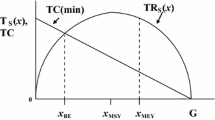Synopsis
Through three versions of a handbook on computations for biological statistics of fish populations, W.E. “Bill” Ricker played a pivotal role in founding the field of quantitative fishery science. His interests, however, extended far beyond the confines of quantifiable events to a deep appreciation for the natural world. In this article, I trace his development of fishery models from the 1940s to the 1970s, using examples that illustrate his approach to statistics and biological systems analysis. I describe changes in technology and statistics that have made it possible to extend his research in new directions, although his approach still lies at the core of all modern fishery models. His gentle, inquiring spirit persisted long after his retirement in 1973, as I illustrate from personal experiences with him during the 1990s.
Similar content being viewed by others
References
N.J.J. Bailey (1951) ArticleTitleOn estimating the size of mobile populations from recapture data Biometrika 38 293–306
R.J.H. Beverton S.J. Holt (1956) ArticleTitleA review of methods for estimating mortality rates in fish populations, with special reference to sources of bias in catch sampling Rapport P.-V. Reunion Conseil Permenant International Exploration de le Mer 140 67–83
Beverton, R.J.H. & S.J. Holt. 1957. On the dynamics of exploited fish populations. U.K. Ministry of Agriculture, Fish & Fisheries Investigations (Ser. 2) 19: 533 pp.
C.A. Chant (1913a) ArticleTitleAn extraordinary meteoric display J. R. Astron. Soc. Can. 7 145–215
C.A. Chant (1913b) ArticleTitleFurther information regarding the meteoric display of February 9, 1913 J. R. Astron. Soc. Can. 7 438–447
D.G. Chapman (1951) ArticleTitleSome properties of the hypergeometric distribution with application to zoological sample censuses Univ. Calif. Publ. Stat. 1 131–160
P. Clifford (1993) ArticleTitleDiscussion on the meeting on the Gibbs sampler and other Markov chain Monte Carlo methods J. R. Stat. Soc. (Series B) 55 53–102
B. Efron (1979b) ArticleTitleComputers and the theory of statistics: Thinking the unthinkable SIAM Rev. 21 460–480 Occurrence Handle10.1137/1021092
Efron, B.E. & R.J. Tibshirani. 1993. An introduction to the bootstrap. Mongraphs on Statistics and Applied Probability, Chapman & Hall, New York, 436 pp.
R.A. Fisher (1925) Statistical Methods for Research Workers Oliver & Boyd Edinburgh 239
R.A. Fisher (1930) The Genetical Theory of Natural Selection Clarendon Press Oxford 272
R.A. Fisher (1935) The Design of Experiments Oliver & Boyd Edinburgh 252
R.A. Fisher (1937) The Design of Experiments EditionNumber2 Oliver & Boyd Edinburgh 260
M. Graham (1952) ArticleTitleOverfishing and optimum fishing Rapport P.-V. Reunion Conseil Permanent International Exploration de le Mer 132 72–78
Jones, R. 1957. A much simplified version of the fish yield equation. Doc. No. P. 21, presented at the Lisbon joint meeting of International Committee on Northwest Atlantic Fisheries, International Council for the Exploration of the Sea, and Food Agriculture Organization, United Nations, 8 pp.
Kuznetsov, Y.A. 1995. Elements of applied bifurcation theory. Applied Mathematical Sciences, Vol. 112, Springer-Verlag, New York, 515 pp.
R.M. May (1976) ArticleTitleSimple mathematical models with very complicated dynamics Nature 261 459–467 Occurrence Handle10.1038/261459a0 Occurrence Handle1:STN:280:CSmB38%2FktVU%3D
R.M. May (2002) The best possible time to be alive G. Farmelo (Eds) It must be Beautiful: Great Equations of Modern Science Granata Books London 28–45
A.M. Mood F.A. Graybill (1963) Introduction to the Theory of Statistics EditionNumber2 McGraw-Hill New York 443
J. Nickell J.F. Fisher (1992) ArticleTitleThe crop-circle phenomenon: An investigative report Skept. Inquirer 16 136–149
J.A. O’Keefe (1968) ArticleTitleNew data on cyrillids J. R. Astron. Soc. Can. 62 97–98
K. Pearson (1948) Tables of the Incomplete Beta-function The University Press Cambridge, U.K. 494
C.G.J. Petersen (1896) ArticleTitleThe yearly immigration of young plaice into the Limfjord from the German Sea, etc Rep. Danish Biol. Stat. 6 1–48
T.J. Quinn SuffixII (2003) ArticleTitleRuminations on the development and future of population dynamics models in fisheries Nat. Res. Model. 16 341–392
Ricker, K. 2001. The scientific and literary publications of W.E. Ricker, O.O.C., Ph.D., D. Sc. LLD, F.R.S.C. (1929 – 2001 and still ongoing). Fisheries & Oceans Canada, Pacific Biological Station Library. Bound manuscript.
Ricker, W.E. 1948. Methods of estimating vital statistics of fish populations. Indiana University Publications, Science Series, No. 15. 101 pp.
Ricker, W.E. 1958. Handbook of computations for biological statistics of fish populations. Bulletin of the Fisheries Research Board of Canada, No. 119. 300 pp.
W.E. Ricker (Eds) (1968) Methods for assessment of fish production in freshwaters Blackwell Scientific Publications Oxford 313
W.E. Ricker (Eds) (1971) Methods for assessment of fish production in freshwaters EditionNumber2 Blackwell Scientific Publications Oxford 348
Ricker, W.E. 1975. Computation and interpretation of biological statistics of fish populations. Bulletin of the Fisheries Research Board of Canada, No. 191. 382 pp.
W.E. Ricker (2006) ArticleTitleOne man’s journey through the years when ecology came of age Environ. Biol. Fishes 75 7–37
D.S. Robson H.A. Regier (1964) ArticleTitleSample size in Petersen mark-recapture experiments Trans. Amer. Fish. Soc. 93 215–226 Occurrence Handle10.1577/1548-8659(1964)93[215:SSIPME]2.0.CO;2
J.T. Schnute (1994) ArticleTitleA general framework for developing sequential fisheries models Can. J. Fish. Aquat. Sci. 51 1676–1688
J.T. Schnute (2003) ArticleTitleDesigning fishery models: A personal adventure Nat. Resour. Model. 16 393–413
I. Stewart (1995) ArticleTitleMathematical recreations: Daisy, daisy, give me your answer do. Sci. Am. 195 96–99
T. Stoppard (1993) Arcadia Faber & Faber London 97
N.J. Wilimovsky E.C. Wiklund (1963) Tables of the incomplete beta function for the calculation of fish population yield Institute of Fisheries, University of British Columbia Vancouver, Canada 291
Author information
Authors and Affiliations
Corresponding author
Rights and permissions
About this article
Cite this article
Schnute, J.T. Curiosity, Recruitment, and Chaos: A Tribute to Bill Ricker’s Inquiring Mind. Environ Biol Fish 75, 95–110 (2006). https://doi.org/10.1007/s10641-005-2444-9
Received:
Accepted:
Issue Date:
DOI: https://doi.org/10.1007/s10641-005-2444-9




